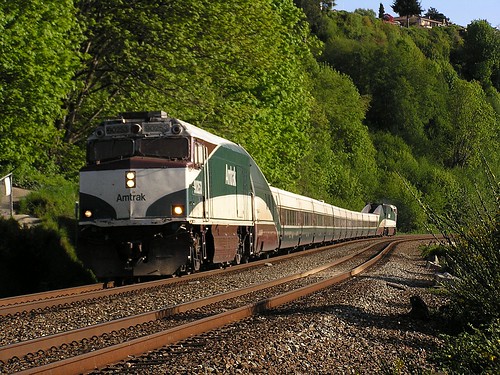Burning the Midnight Oil for Living Energy Independence
also Agent Orange
 Let construction or upgrade of a rail corridor be proposed, and almost immediately the cry goes up, “but we can’t afford it! It costs too much!”.
Let construction or upgrade of a rail corridor be proposed, and almost immediately the cry goes up, “but we can’t afford it! It costs too much!”.
Confusing the response to this cry is that there are two quite different types of “cost too much” – real, and financial.
There first “cost of rail” question is the real cost question: what is the full economic benefit, including all material and energy impacts saved versus other alternative, versus the full economic cost.
___________
Note: The first kind of “cost versus benefit” question is the kind that Ed Gleaser fumbled so badly when he assumed Zero Population Growth in east Texas, no congestion today between Houston and Dallas on the intercity road network, either deliberately or through negligence bypassed important intercity transport demands along the route of his corridor, and presumed that the only available option was the most capital-intensive type of rail corridor, the all-new, all-grade separated, Express High Speed Rail corridor.
____________
The second “cost of rail” question is the financial cost – given the complex, sometimes ad hoc, and often inconsistent sets of rules we have established for allocating resources for both investment in transport infrastructure and paying for transport operations, how do we “pay for” construction or upgrade of those rail corridors that our best analysis of cost and benefit indicate are wise investments.
That second question is what I am looking at today.

 crossposted from
crossposted from  Today, the focus is on one lovely rhetorical ploy used by anti-rail advocates to try to put one over on people with limited experience with trains. This relies on the false framing that “trains is trains”, and uses something that is true about a particular kind of local rail transport to mislead people about 110mph Emerging High Speed Rail in particular.
Today, the focus is on one lovely rhetorical ploy used by anti-rail advocates to try to put one over on people with limited experience with trains. This relies on the false framing that “trains is trains”, and uses something that is true about a particular kind of local rail transport to mislead people about 110mph Emerging High Speed Rail in particular. The people’s choice award in the
The people’s choice award in the  I have blogged on this topic before (links below the fold), and the concept is both powerful and simple. Electrify main rail corridors and provide the capacity to support 100mph Rapid Freight Rail. The points are direct:
I have blogged on this topic before (links below the fold), and the concept is both powerful and simple. Electrify main rail corridors and provide the capacity to support 100mph Rapid Freight Rail. The points are direct: It is widely remarked that the US Department of Transport map of High Speed Rail Corridors leaves a lot of obvious holes.
It is widely remarked that the US Department of Transport map of High Speed Rail Corridors leaves a lot of obvious holes. Morris
Morris  Freakonomist Eric Morris finishes up his tag-team attack with Ed Glaeser on the HSR policy with a post that confesses to the hack jobs both are doing on HSR policy – but works hard to spin the confession into a defense of the hackery.
Freakonomist Eric Morris finishes up his tag-team attack with Ed Glaeser on the HSR policy with a post that confesses to the hack jobs both are doing on HSR policy – but works hard to spin the confession into a defense of the hackery.